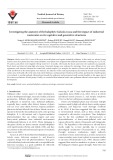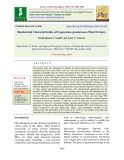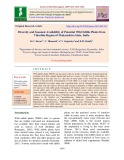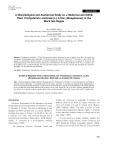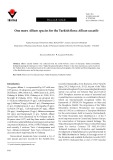
Habitat and flowering plants
-
Salsola crassa M.B. is one of the most successful plants used against industrial pollutants. In this study, we selected young Salsola crassa M.B. plants from their natural habitats. Some plants were irrigated with industrial wastewater containing Fe, Co, Ni, Cu, Pb, and Zn, and others were irrigated with tap water for 3–4 months. Afterwards, the shoots and roots were randomly cut, separated, fixed, dyed, and observed using light microscopy. Structural changes were analyzed by stereology. There were some differences in appearance and structure between the treated and control samples.
 13p
13p  tudichquannguyet
tudichquannguyet
 29-11-2021
29-11-2021
 13
13
 1
1
 Download
Download
-
Paphiopedilum orchids, the most popular and rare orchid genera, are used as potted flowers and cut flowers. In nature condition, the orchid population is threatened with extinction due to over-exploitation and altered habitat. Reduction in this orchids via large-scale micropropagation is a better option to reduce the wild harvest, meets the commercial needs as well as conserves this threatened orchid. This orchid can be propagated by germinating seeds under in vitro culture condition; however, they are difficult for micropropagation, especially regenerating plantlets from in vitro culture.
 9p
9p  nguyenxuankha_bevandan
nguyenxuankha_bevandan
 14-08-2020
14-08-2020
 13
13
 1
1
 Download
Download
-
The present study was undertaken to identify the phytochemicals present in Eupatorium glandulosum of leaf, stem, flower and root. The use of natural plant part resources for applying ecofriendly finish for textiles has opened up new avenues in this area of research. Eupatorium glandulosum (Ageratina adenophora) belongs to the family Asteraceae. Asteraceae is one of the largest families of vascular plants, distributed over most of the earth and in almost all habitats and comprises of nearly 1200 species distributed mainly in the tropical regions of Americas, Europe, Africa, and Asia.
 6p
6p  kequaidan4
kequaidan4
 21-04-2020
21-04-2020
 6
6
 1
1
 Download
Download
-
Wild edible plants (WEPs) are the species that are neither cultivated nor domesticated, but available from their natural habitat and used as a source of food. Use of wild edibles is diminishing at fast pace but it is clear that in many parts of the world the use of wild edibles is still prevalent. Consumption of wild edibles is a major source of vitamins and micro-nutrients for people using only vegetarian diets rich in carbohydrates.
 13p
13p  cothumenhmong1
cothumenhmong1
 08-12-2019
08-12-2019
 14
14
 2
2
 Download
Download
-
Trachystemon orientalis (L.) G.Don (Boraginaceae), which is distributed in various habitats in the Black Sea region, was investigated morphologically and anatomically. The flowering branches, leaves and rhizomes of T. orientalis are used as food. This species is a Euro-Siberian floristic element.
 8p
8p  vineptune2711
vineptune2711
 31-10-2019
31-10-2019
 8
8
 0
0
 Download
Download
-
Allium saxatile M.Bieb. was collected from the north-western corner of European Turkey (Demirköy, Kırklareli) during the field survey of the “Yıldız Mountain Biosphere Project”. It has been reported as a new record for the Turkish flora. A description based on the collected specimens, photographs of its habitat and flowering plants, map of the distribution area, and its karyotype are given.
 6p
6p  vi4mua
vi4mua
 24-02-2019
24-02-2019
 10
10
 1
1
 Download
Download
CHỦ ĐỀ BẠN MUỐN TÌM









